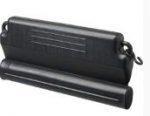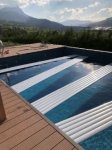I have a pool (8 x 5 x 1,5 meter) in the French Alps. It consists of concrete walls with liner.
This year I have mounted a roll cover (hollow PVC slats (not the solar type), the roll is submerged at the bottom of the pool).
During winter the pool will freeze. The previous years I've put a diagonally line of winter floaters trough the pool as instructed by the pool builder to protect the concrete. What to do this winter, results in contradictory advises between the company where I bought the cover and the manufacturer.
and here it becomes 'vague'. The winter floaters will always lift the slats a little. Since the slats are heavy, it's like 1 or 2 cm. So I asked the manufacturer and the vendor what to do. Should I maybe use a specific type of floater, or no floater, or ...
I got these answers:
Both parties are very slow and incomplete when answering.
Does anyone has got real experience with this situation? Can I trust the closed cover(which is on top of the water?!) to take enough pressure from the concrete walls (to be honest I find the concept of the floaters confusing anyway - because the floater is only in the top 30cm of water, and below it, is one big chunk of ice. But that at least has proven itself the last years).
thxs for the help!
This year I have mounted a roll cover (hollow PVC slats (not the solar type), the roll is submerged at the bottom of the pool).
During winter the pool will freeze. The previous years I've put a diagonally line of winter floaters trough the pool as instructed by the pool builder to protect the concrete. What to do this winter, results in contradictory advises between the company where I bought the cover and the manufacturer.
- There is consensus I should fully roll-out the cover during winter and let it freeze-in
- The manufacturer writes in an online manual, that in case of heavy frost, one should put the winter floaters underneath the cover. But: The winter floaters should not 'lift the slats to much' so the will deform
and here it becomes 'vague'. The winter floaters will always lift the slats a little. Since the slats are heavy, it's like 1 or 2 cm. So I asked the manufacturer and the vendor what to do. Should I maybe use a specific type of floater, or no floater, or ...
I got these answers:
- Vendor: You need to protect your concrete, so put the floaters underneath the cover. Deformation won't be a big issue.
- Manufacturer: You do NOT need floaters. The pool cover will act as floater (and no explanation why they advise differently in the online manual)
Both parties are very slow and incomplete when answering.
Does anyone has got real experience with this situation? Can I trust the closed cover(which is on top of the water?!) to take enough pressure from the concrete walls (to be honest I find the concept of the floaters confusing anyway - because the floater is only in the top 30cm of water, and below it, is one big chunk of ice. But that at least has proven itself the last years).
thxs for the help!


 This time of year, we have many pool owners who are closing their concrete/plaster pools. But our process is a bit different as you can tell from reading our
This time of year, we have many pool owners who are closing their concrete/plaster pools. But our process is a bit different as you can tell from reading our 



